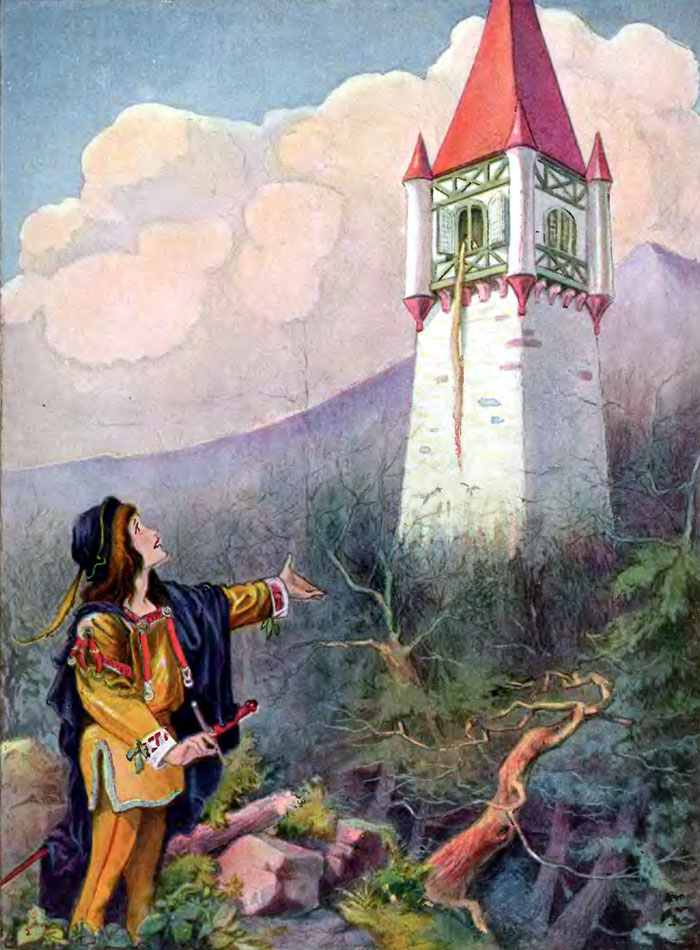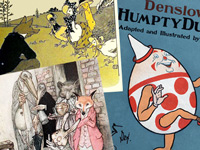Rapunzel

"Rapunzel" (/rəˈpʌnzəl/; German pronunciation: [ʁaˈpʊnt͡səl]) is a German fairy tale in the collection assembled by the Brothers Grimm, and first published in 1812 as part of Children's and Household Tales. The Grimm Brothers' story is an adaptation of the fairy tale Rapunzel by Friedrich Schulz published in 1790. The Schulz version is based on Persinette by Charlotte-Rose de Caumont de La Force originally published in 1698 which in turn was influenced by an even earlier tale, Petrosinella by Giambattista Basile, published in 1634. Its plot has been used and parodied in various media and its best known line ("Rapunzel, Rapunzel, let down your hair") is an idiom of popular culture. In volume I of the 1812 annotations (Anhang), it is listed as coming from Friedrich Schulz Kleine Romane, Book 5, pp. 269–288, published in Leipzig 1790.
In the Aarne–Thompson classification system for folktales it is type 310, "The Maiden in The Tower". Andrew Lang included it in The Red Fairy Book. Other versions of the tale also appear in A Book of Witches by Ruth Manning-Sanders and in Paul O. Zelinsky's 1997 Caldecott Medal-winning picture book, Rapunzel and the Disney movie Tangled.
Rapunzel's story has striking similarities to the 10th-century Persian tale of Rudāba, included in the epic poem Shahnameh by Ferdowsi. Rudāba offers to let down her hair from her tower so that her lover Zāl can climb up to her. Some elements of the fairy tale might also have originally been based upon the tale of Saint Barbara, who was said to have been locked in a tower by her father.
Plot
A lonely couple, who want a child, live next to a walled garden belonging to an evil witch named Dame Gothel. The wife, experiencing the cravings associated with the arrival of her long-awaited pregnancy, notices a rapunzel plant (or, in most translated-to-English versions of the story, rampion), growing in the garden and longs for it, desperate to the point of death. One night, her husband breaks into the garden to get some for her. She makes a salad out of it and greedily eats it. It tastes so good that she longs for more. So her husband goes to get some for her a second time. As he scales the wall to return home, Dame Gothel catches him and accuses him of theft. He begs for mercy, and she agrees to be lenient, and allows him to take all he wants, on condition that the baby be given to her at birth. Desperate, he agrees. When the baby is born, Dame Gothel takes her to raise as her own and names her Rapunzel after the plant her mother craved. She grows up to be the most beautiful child in the world with long golden hair. When she reaches her twelfth year, Dame Gothel shuts her away in a tower in the middle of the woods, with neither stairs nor a door, and only one room and one window. When she visits her, she stands beneath the tower and calls out:
"Rapunzel, Rapunzel, let down your hair, so that I may climb your golden hair.
One day, a prince rides through the forest and hears Rapunzel singing from the tower. Entranced by her ethereal voice, he searches for her and discovers the tower, but is naturally unable to enter it. He returns often, listening to her beautiful singing, and one day sees Dame Gothel visit, and thus learns how to gain access to Rapunzel. When Dame Gothel leaves, he bids Rapunzel let her hair down. When she does so, he climbs up, makes her acquaintance, and eventually asks her to marry him. She agrees.
Together they plan a means of escape, wherein he will come each night (thus avoiding the Dame Gothel who visits her by day), and bring Rapunzel a piece of silk, which she will gradually weave into a ladder. Before the plan can come to fruition, however, she foolishly gives the prince away. In the first edition of Grimm's Fairy Tales, she innocently says that her dress is getting tight around her waist (indicating pregnancy); in the second edition, she asks Dame Gothel (in a moment of forgetfulness) why it is easier for her to draw up the prince than her. In anger, she cuts off Rapunzel's hair and casts her out into the wilderness to fend for herself.
When the prince calls that night, Dame Gothel lets the severed hair down to haul him up. To his horror, he finds himself staring at her instead of Rapunzel, who is nowhere to be found. When she tells him in anger that he will never see Rapunzel again, he leaps from the tower in despair and is blinded by the thorns below. In another version, she pushes him and he falls on the thorns, thus becoming blind.
For months, he wanders through the wastelands of the country and eventually comes to the wilderness where Rapunzel now lives with the twins she has given birth to, a boy and a girl. One day, as she sings, he hears her voice again, and they are reunited. When they fall into each other's arms, her tears immediately restore his sight. He leads her and their children to his kingdom, where they live happily ever after.
In some versions of the story, Rapunzel's hair magically grows back after the prince touches it.
Another version of the story ends with the revelation that Dame Gothel had untied Rapunzel's hair after the prince leapt from the tower, and it slipped from her hands and landed far below, leaving her trapped in the tower.
LITERATURE FAIRY TALES

Rapunzel: Illustration by Johnny Gruelle

Rapunzel: Illustration by Johnny Gruelle
( Click image to enlarge)
A fairy tale is a type of short story that typically features folkloric fantasy characters, such as dwarves, elves, fairies, giants, gnomes, goblins, mermaids, trolls, or witches, and usually magic or enchantments. Fairy tales may be distinguished from other folk narratives such as legends (which generally involve belief in the veracity of the events described) and explicitly moral tales, including beast fables. The term is mainly used for stories with origins in European tradition and, at least in recent centuries, mostly relates to children's literature.
Read More » List of Fairy tales »
RESOURCES
This article uses material from the Wikipedia articles "List of fairy tales", "Fairy tale" and "Rapunzel", which is released under the Creative Commons Attribution-Share-Alike License 3.0.
© Stories Preschool. All Rights Reserved.





